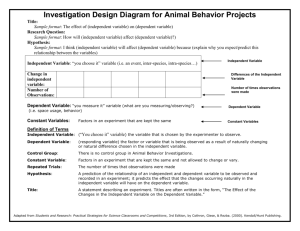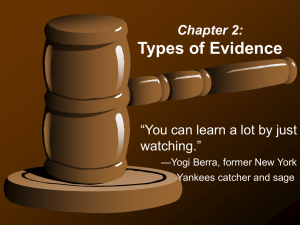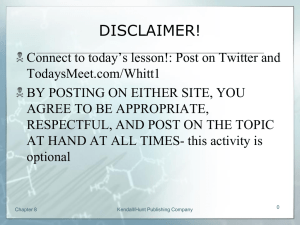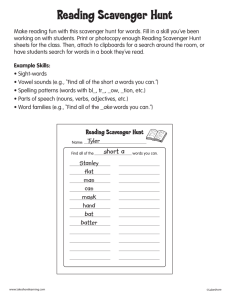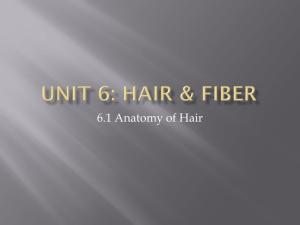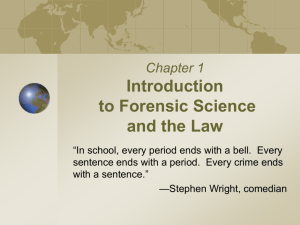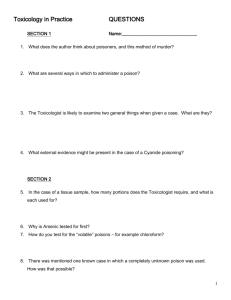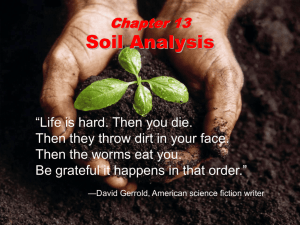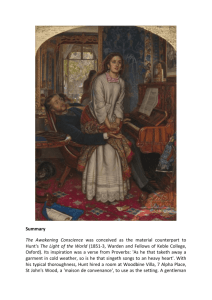Science Fair Project
advertisement
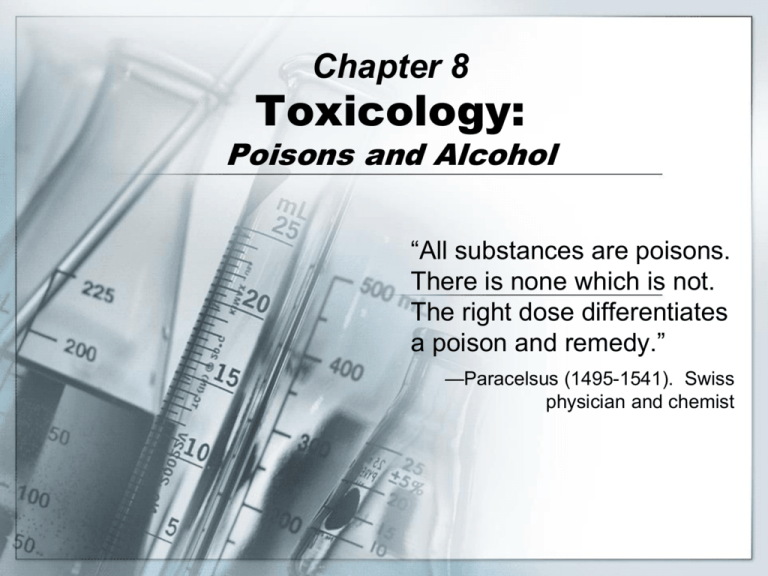
Chapter 8 Toxicology: Poisons and Alcohol “All substances are poisons. There is none which is not. The right dose differentiates a poison and remedy.” —Paracelsus (1495-1541). Swiss physician and chemist Toxicology and Alcohol Students will be able to: Chapter 8 Discuss the connection of blood alcohol levels to the law, incapacity, and test results. Understand the vocabulary of poisons. Design and conduct scientific investigations. Use technology and mathematics to improve investigations and communications. Identify questions and concepts that guide scientific investigations. Communicate and defend a scientific argument. Kendall/Hunt Publishing Company 1 Toxicology Definition—the study of the adverse effects of chemicals or physical agents on living organisms. Types: Environmental—air, water, soil Consumer—foods, cosmetics, drugs Medical, clinical, forensic Chapter 8 Kendall/Hunt Publishing Company 2 Uses of Forensic Toxicology Postmortem—medical examiner or coroner Criminal—motor vehicle accidents (MVA) Workplace—drug testing Sports—human and animal Environment—industrial, catastrophic, terrorism Chapter 8 Kendall/Hunt Publishing Company 3 Toxicology Toxic substances may: Be a cause of death Contribute to death Cause impairment Explain behavior Chapter 8 Kendall/Hunt Publishing Company 4 Historical Perspective of Poisoners Olympias—a famous Greek poisoner, mother of Alexander the Great (375 - 316 BC) Locusta—personal poisoner of Emperor Nero (54 AD) Lucretia Borgia—father was Pope Alexander VI (1480-1519) Catherine Medici- Queen of France poisoned political rivals, and experimented with poisons on the poor (1519-1589 AD) Madame Giulia Toffana—committed over 600 successful poisonings, including two Popes (1659 AD) Hieronyma Spara—formed a society to teach women how to murder their husbands (1659 AD) Madame de Brinvilliers and Catherine Deshayes—Convicted French witches poisoners. (1640 - 1680 AD) Chapter 8 Kendall/Hunt Publishing Company 5 People of Historical Significance Mathieu Orfila—known as the father of forensic toxicology, published in 1814 “Traite des Poisons” which described the first systematic approach to the study of the chemistry and physiological nature of poisons. Chapter 8 Kendall/Hunt Publishing Company 6 Aspects of Toxicity Dosage The chemical or physical form of the substance The mode of entry into the body Body weight and physiological conditions of the victim, including age and sex The time period of exposure The presence of other chemicals in the body or in the dose Chapter 8 Kendall/Hunt Publishing Company 7 Lethal Dose LD50—refers to the dose of a substance that kills half the test population, usually within four hours Expressed in milligrams of substance per kilogram of body weight Chapter 8 Kendall/Hunt Publishing Company 8 Toxicity Classes LD50 (rat,oral) Correlation to Ingestion by 150 lb Adult Human Toxicity <1mg/kg a taste to a drop Extremely 1-50 mg/kg to a teaspoon highly 50-500 mg/kg to an ounce moderately 500-5000 mg/kg to a pint slightly 5-15 g/kg to a quart Practically non-toxic Over 15g/kg more than 1 quart Relatively harmless Chapter 8 Kendall/Hunt Publishing Company 9 Federal Regulatory Agencies Food and Drug Administration (FDA) Environmental Protection Agency (EPA) Consumer Product Safety Commission Department of Transportation (DOT) Occupational Safety and Health Administration (OSHA) Chapter 8 Kendall/Hunt Publishing Company 10 Symptoms of Various Types of Poisoning Type of Poison Symptom/Evidence Caustic Poison (lye) Characteristic burns around the lips and mouth of the victim Red or pink patches on the chest and thighs, unusually bright red lividity Black vomit Greenish-brown vomit Yellow vomit Coffee brown vomit. Onion or garlic odor Burnt almond odor Pronounced diarrhea Nausea and vomiting, unconsciousness, possibly blindness Carbon Monoxide Sulfuric acid Hydrochloric acid Nitric acid Phosphorous Cyanide Arsenic, Mercury Methyl (wood) or Isopropyl (rubbing) alcohol Chapter 8 Kendall/Hunt Publishing Company 11 Critical Information on Poisons Form Common color Characteristic odor Solubility Taste Common sources Lethal dose Mechanism Possible methods of administration Time interval of onset of symptoms. Chapter 8 Symptoms resulting from an acute exposure Symptoms resulting from chronic exposure Disease states mimicked by poisoning Notes relating to the victim Specimens from victim Analytical detection methods Known toxic levels Notes pertinent to analysis of poison List of cases in which poison was used —John Trestrail from “Criminal Poisoning” Kendall/Hunt Publishing Company 12 To Prove a Case Prove a crime was committed Motive Intent Access to poison Access to victim Death was caused by poison Death was homicidal Chapter 8 Kendall/Hunt Publishing Company 13 Forensic Autopsy Look for: Irritated tissues Characteristic odors Mees lines—single transverse white bands on nails. Order toxicological screens Postmortem concentrations should be done at the scene for comparison No realistic calculation of dose can be made from a single measurement Chapter 8 Kendall/Hunt Publishing Company 14 People in the News John Trestrail is a practicing toxicologist who has consulted on many criminal poisoning cases. He is the founder of the Center for the Study of Criminal Poisoning in Grand Rapids, Michigan which has established an international database to receive and analyze reports of homicidal poisonings from around the world. He is also the director of DeVos Children’s Hospital Regional Poison Center. In addition, he wrote the book, Criminal Poisoning, used as a reference by law enforcement, forensic scientists and lawyers. Chapter 8 Kendall/Hunt Publishing Company 15 More Information Read more about Forensic Toxicology from Court TV’s Crime Library at: http://www.crimelibrary.com/criminal_mind/forensic s/toxicology/2.html Chapter 8 Kendall/Hunt Publishing Company 16
